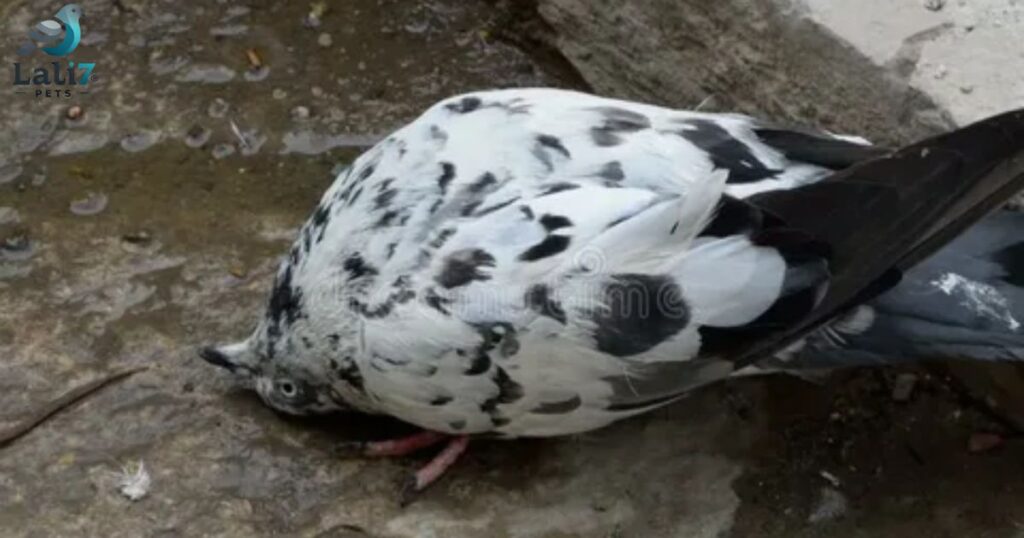If you’ve ever kept pigeons, you might have heard of PMV. It sounds technical, but let’s break it down in a way that makes sense for everyone. In this guide, we’ll walk you through what PMV for pigeons is, how to recognize it, how to treat it, and, most importantly- how to prevent it.
What is PMV in Pigeons?
PMV stands for Pigeon Paramyxovirus, a strain of Avian Paramyxovirus Type 1, which also causes Newcastle disease in chickens. It mainly affects pigeons’ nervous system, kidneys, and digestive system.
While humans and other animals don’t get infected, humans who touch their eyes after handling a pigeon with PMV might develop conjunctivitis. So hygiene is key.
What Causes PMV in Pigeons

PMV in pigeons is usually spread through:
- Contaminated water or food
- Inhalation of infected droppings or dust
- Close contact with infected birds
- Contaminated equipment, hands, or clothing
Stress, overcrowding, and poor living conditions increase the risk of an outbreak.
PMV Pigeon Symptoms

PMV can cause a wide range of symptoms, some mild, some severe. Let’s look at what you might see.
Common Symptoms of PMV
- Watery droppings (caused by kidney inflammation)
- Increased water intake
- Dilated, fluid-filled crop
- Difficulty flying or walking
- Twisting neck or head (torticollis)
- Spiraling or flying backward
- Fits or seizures
Here’s a real-life story: A fancier once shared how their strongest bird started tossing seeds and flying in circles. At first, they thought it was just fatigue, but within a day, the pigeon could barely stand. It turned out to be PMV.
How Long is the Incubation Period?
PMV symptoms usually show up 2 to 10 days after exposure. However, some birds may not show symptoms for weeks, making it tricky to detect.
Once infected, a pigeon may shed the virus for up to 60 days.
How to Diagnose PMV in Pigeons
The symptoms are usually a giveaway. But for confirmation, vets use:
- PCR Tests (cloacal/throat swabs)
- HI antibody tests (check for exposure)
- Tissue biopsy from deceased birds
Early diagnosis helps start supportive care faster.
Step-by-Step: How to Care for a Pigeon with PMV
1. Isolate the Pigeon
Keep the infected bird in a quiet, warm environment (25–30°C). Avoid bright lights. Use towels as bedding to prevent feather damage during fits.
2. Feeding and Watering
Pigeons with PMV often miss their food. Use a deep dish to help them peck correctly. Offer soft foods:
- Thawed peas and corn (not canned)
- Soaked dog biscuits
- Pellets soaked in water
Watch for dehydration. Provide water with electrolytes in a deep, narrow bowl to avoid drowning.
3. Supportive Care
- Multivitamins to boost immunity
- Probiotics for gut health
- Daily weighing and poop count (20–30 droppings/day is normal)
Anecdote: One rescuer used calcium syrup with Vitamin D3 — just two drops for 3 days, and noticed steady improvement.
PMV in Pigeon Treatment

There is no specific cure, but many pigeons recover with supportive care. The nervous signs, like head twisting or tremors, may fade or persist. Recovery can take 6 to 12 weeks sometimes longer.
Some fanciers use home remedies to support recovery, like garlic-infused water, apple cider vinegar, and turmeric, though results may vary.
Paramyxovirus in Pigeons: Home Remedies
Some pigeon keepers try homeopathy and traditional treatments for neurological symptoms:
- Conium Maculatum for paralysis (30c potency, 3x/day for 10 days)
- Argentum Nit for tremors
- Belladonna for seizures
Important: Don’t touch the pills with your hands. Give them on an empty stomach, 20 mins before/after feeding.
PMV for Pigeons Schedule
Vaccination Timeline
Vaccination is the best defense.
Types of PMV Vaccines:
- La Sota (inactivated)
- NDV4 (live, modified)
In Australia, La Sota is commonly used. It provides high immunity when given twice 4–8 weeks apart. Annual boosters are recommended.
How to Vaccinate
- Use a 0.5 ml subcutaneous injection
- Best spot: loose skin at the base of the neck
- Use 21G or 18G needles
- Disinfect the area and store the vaccine at 2–8°C
Tip: Use a vaccination gun for larger flocks.
Loft Management & Hygiene
- Isolate new pigeons for 10 days before introducing them to your loft
- Disinfect drinkers and feeders with bleach solution regularly
- Use separate clothing and shoes for your isolation area
- Wash your hands thoroughly after handling any sick birds
Frequently Asked Questions (FAQ)
What does PMV do to pigeons?
PMV attacks the nervous system, kidneys, and digestive system of pigeons, causing symptoms like head twisting, watery droppings, and loss of coordination.
What is the PMV vaccine for pigeons?
The PMV vaccine (such as La Sota or NDV4) helps pigeons build immunity against Paramyxovirus and is administered annually via subcutaneous injection.
How long is PMV contagious in pigeons?
Infected pigeons can shed the PMV virus and remain contagious for up to 60 days, even if they show no visible symptoms.
Can a pigeon recover from PMV?
Yes, with proper supportive care, many pigeons recover from PMV, although neurological symptoms may persist for weeks or even months.
How do you treat PMV in pigeons at home?
Home treatment includes isolation, feeding soft foods, giving multivitamins, electrolytes, and using natural remedies like garlic water or apple cider vinegar to boost immunity.
Final Thoughts: PMV Doesn’t Mean the End
Seeing your pigeon suffer from PMV is heartbreaking, but with knowledge and care, recovery is possible. Prevention is your strongest tool. So, vaccinate your pigeons, maintain good hygiene, and act fast if symptoms appear.
Many fanciers who experienced a PMV outbreak thought it was the end, only to watch their birds recover fully and fly again. One even shared, “The same bird that couldn’t peck straight won the next local race six months later.”

